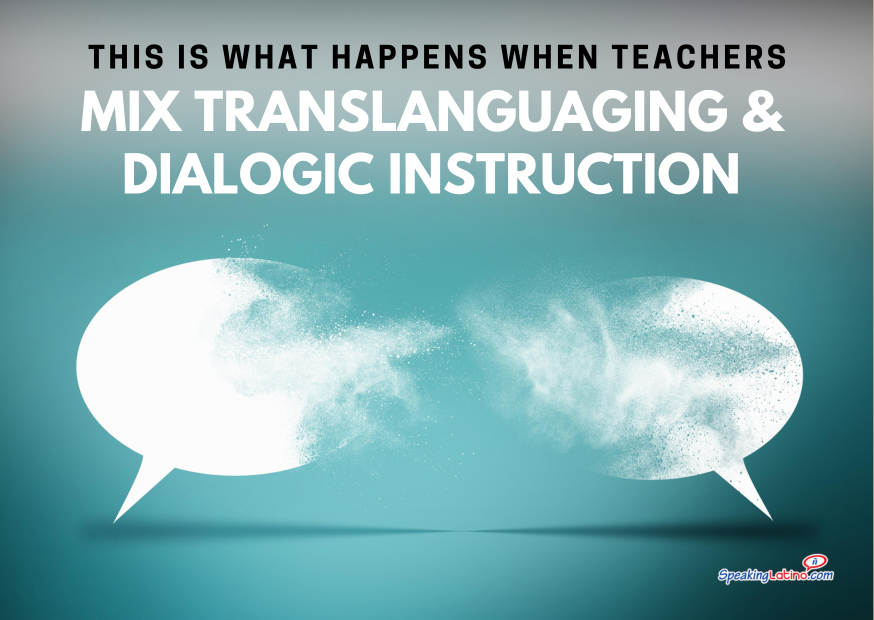
The content of this article is based on the presentation, Authentic Questioning and Dialogic Instruction by Timothy Chávez, which was part of the World Language Teacher Summit.
Integrating Translanguaging and Dialogic Instruction
Incorporating dynamic classroom techniques can significantly impact student engagement and comprehension. Ever thought about bringing together translanguaging and dialogic instruction? It's all about getting students to really dig into texts and think critically about what they're learning.
When you shake things up like this, students get to see stuff from different angles, and it makes the classroom feel more welcoming for everyone. Plus, it's not just about learning a language; it's about boosting those brain muscles for critical thinking and empathy too.
Understanding Translanguaging
Translanguaging, a pedagogical method that involves the seamless use of multiple languages, encourages students to utilize their full linguistic repertoire while engaging with content.
It's especially awesome in classrooms where you've got lots of different languages floating around. Students naturally blend their native language with the target language, fostering a comfortable environment where they can articulate their thoughts more freely. The idea is to make students feel totally stress-free, so they can express themselves in whatever language feels right. As students become more comfortable, they find themselves using the target language more frequently. It's like a win-win situation.
But it's not just about switching between languages randomly. This approach supports the idea that students' native languages are assets rather than barriers in the learning process. When students mix Spanish and English, for example, they navigate and negotiate meaning more effectively, enhancing their cognitive abilities.
And if you wanna dive deeper into this method, you can check out resources like the World Language Classroom Podcast. They've got all sorts of tips and tricks for bringing translanguaging into your classroom.
Facilitating Dialogic Instruction
Dialogic instruction is a teaching method centered around open dialogue and critical inquiry. In other words, dialogic instruction is about getting everyone talking and thinking, instead of just handing out answers on a silver platter. Teachers ask questions that really make you stop and ponder, sparking discussions that go deeper than just skimming the surface. This approach transitions the focus from mere comprehension to interpretation, prompting learners to analyze texts critically and articulate their viewpoints.
Implementing dialogic instruction involves several key techniques. Utilizing "turn and talk" sessions where students share their interpretations with peers fosters collaborative learning. Asking about missing elements in a text engages students in critical thinking, requiring them to hypothesize and infer.
By doing so, students move beyond surface-level understanding and explore the underlying themes and perspectives within the text. So, it's not about just getting the gist of things; it's about digging deep into what the text is really saying and sharing your own take on it.
Transforming Basic Comprehension Questions Into Interpretation Questions
The heart of dialogic instruction lies in authentic questioning. Such questioning encourages students to engage with texts on a deeper level, moving from comprehension to interpretation and critical analysis.
Inquiry should be structured to allow students to think beyond the literal meaning of the text. Transforming basic comprehension questions into interpretation questions prompts learners to explore broader themes and implications.
For instance, instead of asking students what happened in a story, one might ask why a character acted in a certain way or how different characters might perceive an event differently. These kinds of questions don't just scratch the surface; they dive deep into the meaning behind the text. They get students thinking about all sorts of different angles and motivations, so they come away with a richer understanding of what they're reading.
Integrating Social Justice in Dialogue
Bringing social justice into classroom talks is like putting on special glasses that help students see texts in a whole new light. It's not just about dissecting the story; it's about digging into issues like fairness, empathy, and what's happening in the world.
Teachers might toss out different perspectives to look at a text, like how gender roles play out or the gap between rich and poor. But here's where it gets really cool: letting students pick their own social justice lens to zoom in on. That way, they're not just passive learners—they're taking charge of their own learning journey.
Whether they're digging into the psychological twists of a story set on a deserted island or unpacking the emotional baggage in personal relationships, this approach gets them thinking about how fiction connects to real-life stuff happening around them. It's like reading between the lines and finding meaning that goes way beyond the page.
Analyzing Text Through a Social Justice Lens
Encouraging students to analyze texts through a social justice lens is imperative in developing their critical thinking skills and empathy. This means, looking at stories and thinking about how they relate to real-life issues like gender equality, class differences, and mental health. By doing so, students learn to question and challenge societal norms and injustices.
When analyzing a story about a woman's excitement to see her friends contrasted with her lack of enthusiasm for her husband, students delve into the concept of emotional labor within relationships. This discussion can reveal the unequal emotional burdens often placed on women. Further, examining the gender dynamics in the story helps students understand broader societal issues related to gender roles and expectations.
Similarly, exploring a story set on a remote island allows students to investigate class inequality and power dynamics. Socioeconomic status impacts characters' responses to danger and influences the power structure within the group, providing rich material for discussion on social stratification and justice.
And let's not forget about mental health. Being stuck on an island with all sorts of drama unfolding? That's a recipe for some serious stress. When students dig into how the characters cope—or don't cope—it opens up discussions about the effects of betrayal, revenge, and toxic relationships on mental well-being.
Techniques for Classroom Implementation
Several practical techniques support the implementation of translanguaging and dialogic instruction. Teachers can begin by encouraging students to use their native language to look up keywords and concepts, gradually increasing the use of the target language. This scaffolded approach helps build language proficiency while maintaining comprehension and engagement. It's like building a bridge between languages, making sure everyone's on the same page while boosting language skills.
Then there's the art of disagreeing politely. Teachers can hand out sentence starters like "I see where you're coming from, but..." or "Here's another way to look at it..." This way, students can have a debate without things getting too heated, keeping the conversation respectful and productive.
And don't forget about the power of group chats. Giving students a chance to hash things out in pairs or small groups before speaking up in front of everyone makes sure no one's left out. It's all about creating a safe space where every voice matters.

Dialogic instruction is a teaching method centered around open dialogue and critical inquiry.
Building Empathy and Critical Thinking
Here's the scoop on why mixing translanguaging and dialogic instruction is such a game-changer: it's all about boosting empathy and critical thinking skills.
When students start looking at texts from all sorts of angles, it's like they're stepping into someone else's shoes. They get a real feel for different experiences and points of view, which helps them become more understanding the complexities of human behavior and social structures.
Critical thinking is similarly enhanced. By picking apart texts and questioning what's going on, students learn to spot biases, see where inequality sneaks in, and challenge the status quo. It's like they're getting a behind-the-scenes look at how the world works, getting them ready to speak up and make a difference as they grow up.
Engaging with Texts Multiple Times
Engaging with texts multiple times through different lenses is another effective strategy. Initial readings can focus on literal comprehension, ensuring that students grasp the basic plot and characters. Subsequent readings can then delve into nonliteral comprehension and thematic analysis, encouraging students to consider deeper meanings and implications.
Analyzing a text through varied perspectives, such as sociopolitical contexts or psychological motivations, allows students to uncover new layers of understanding with each reading. This iterative process reinforces learning and promotes a more comprehensive grasp of the material.
FAQs About Translanguaging and Dialogic Instruction
What role does translanguaging play in promoting a deeper understanding of texts?
Translanguaging plays a pivotal role in enhancing students' comprehension of texts by leveraging multiple languages to facilitate communication and deepen understanding.
- Bridging Linguistic Gaps: Translanguaging allows students to transcend language barriers and access a wider range of vocabulary and linguistic resources, enabling them to engage more effectively with complex texts and ideas.
- Empowering Expression: By embracing translanguaging strategies, teachers empower students to express themselves in the language(s) they are most comfortable with, fostering a sense of inclusivity and encouraging active participation in literary analysis.
- Cultural Connections: Translanguaging encourages students to explore connections between languages, cultures, and concepts present in texts, promoting a more comprehensive understanding of literary works and facilitating cross-cultural communication and empathy.
- Holistic Interpretation: Through translanguaging, students can develop a more nuanced interpretation of texts by drawing on diverse linguistic resources and cultural perspectives, enriching their analysis and appreciation of literary content.
- Enhanced Engagement: The use of translanguaging techniques in the classroom not only deepens students' engagement with texts but also cultivates a supportive and inclusive learning environment where linguistic diversity is celebrated and leveraged to promote deeper understanding and critical analysis.
- Promoting Multilingualism: Translanguaging fosters the development of multilingual skills and encourages students to embrace their linguistic repertoire, leading to increased confidence in navigating texts in different languages and fostering a more profound connection with the material being studied.
- Facilitating Cross-Cultural Understanding: By incorporating translanguaging practices, educators can facilitate cross-cultural understanding and appreciation among students, encouraging them to explore diverse perspectives and interpretations of texts while building empathy and respect for linguistic and cultural diversity.
- Overall Impact: Translanguaging serves as a powerful tool for promoting a deeper understanding of texts by leveraging students' linguistic abilities and cultural backgrounds to enhance comprehension, critical analysis, and engagement with literary content, ultimately enriching the learning experience and fostering a more profound connection with the material studied.
How can teachers create more engaging questions to facilitate deeper student engagement and critical thinking in the classroom?
Here are some cool strategies you can use to jazz up your questions and get students really thinking:
- Open-Ended Questions: Encourage critical thinking by posing open-ended questions that require students to provide detailed responses, analyze information, and justify their answers.
- Authentic Inquiry: Design questions that prompt students to explore real-world issues, make connections to their own experiences, and delve into complex topics that spark curiosity and deeper reflection.
- Multifaceted Questions: Craft questions that address multiple dimensions of a topic, challenging students to consider various perspectives, analyze different aspects, and engage in comprehensive thinking.
- Textual Analysis: Develop questions that require students to analyze texts, identify key themes, evaluate evidence, and draw conclusions based on textual evidence, promoting close reading and critical interpretation.
- Comparative Questions: Encourage students to compare and contrast different texts, ideas, or viewpoints, fostering critical thinking skills, analytical reasoning, and the ability to make connections across diverse sources.
- Socratic Questioning: Utilize the Socratic method to ask probing questions that encourage students to think deeply, examine assumptions, clarify concepts, and engage in meaningful dialogue to arrive at well-reasoned conclusions.
- Divergent Thinking: Pose questions that stimulate divergent thinking, creativity, and originality by encouraging students to generate multiple solutions, perspectives, or interpretations to a given problem or scenario.
- Real-World Applications: Frame questions that relate classroom content to real-life situations, challenges, or current events, prompting students to apply their knowledge, think critically, and consider the practical implications of their learning. You can get ideas from these scaffolded cultural activities.
- Peer Discussion: Encourage collaborative discussions where students can engage in dialogue, share diverse viewpoints, challenge each other's ideas, and collectively explore complex questions to deepen their understanding and critical thinking skills .
- Feedback and Reflection: Provide opportunities for students to reflect on their responses to questions, receive feedback on their reasoning and analysis, and engage in metacognitive processes that enhance their ability to think critically and improve their responses over time .

Authentic questioning encourages students to engage with texts on a deeper level
How can the combination of translanguaging and dialogic instruction enhance language acquisition and cognitive development?
Combining translanguaging and dialogic instruction is like a power duo for boosting language skills and brainpower. Here's how:
- Linguistic Flexibility: Letting students switch between languages freely opens up a whole world of linguistic possibilities. They get to explore different ways of expressing themselves, which helps them pick up new languages faster and become more fluent.
- Cognitive Engagement: When teachers encourage students to ask questions and really think things through, it's like a mental workout. They're not just memorizing stuff—they're analyzing, synthesizing, and evaluating information, which builds up their brain muscles.
- Metacognitive Skills: By reflecting on how they're using language and reasoning things out, students become more aware of their own learning process. They can figure out what works best for them and fine-tune their language skills accordingly.
- Cultural Understanding: Talking about different cultural perspectives and language quirks helps students see the world from all sorts of angles. It's like a crash course in empathy and understanding, which makes learning languages even more meaningful.
- Complex Thinking: When students dive into discussions that cross language boundaries, they're really stretching their brains. They're not just thinking in one language; they're making connections and analyzing information in all sorts of ways.
- Social Interaction: Getting students to chat with each other and hash out ideas is key to language learning. It's not just about talking; it's about collaborating, negotiating, and building knowledge together.
- Higher-Order Language Skills: Mixing translanguaging and dialogic instruction helps students master the fancy stuff like inference-making and evaluation. These skills aren't just handy for language learning; they're essential for all sorts of intellectual growth.
- Problem-Solving Abilities: When students tackle tricky texts and have to defend their ideas, they're honing their problem-solving skills. It's like a puzzle where they have to piece together evidence and arguments to make sense of things.
- Enhanced Memory Retention: Engaging in discussions that mix languages helps students connect new ideas with stuff they already know, which makes it stick in their brains better.
- Overall Cognitive Growth: By bringing translanguaging and dialogic instruction into the mix, teachers aren't just teaching languages—they're shaping young minds. It's all about stimulating different parts of the brain, fostering critical thinking, and helping students really get the hang of language and content.
Hitting the Jackpot for Language Learning
Bringing together translanguaging and dialogic instruction is like hitting the jackpot for language learning, critical thinking, and social awareness in the classroom. It's all about getting students to use every language trick up their sleeves and dive deep into meaningful conversations.
When students start chatting away in all their languages and really getting into discussions, it's like a whole new world opens up. And when you throw in analyzing texts through a social justice lens, things get even more interesting. They start seeing the world from different perspectives, building empathy, and understanding how complex things really are out there.
But here's the kicker: it's not just about talking the talk. Teachers can use practical techniques and ask the right questions to create a vibe where everyone feels included and empowered to speak their minds. It's like turning the classroom into a place where learning isn't just about memorizing facts—it's about thinking critically and engaging with the world around us.
Discover more language teaching techniques to help you in your classroom.